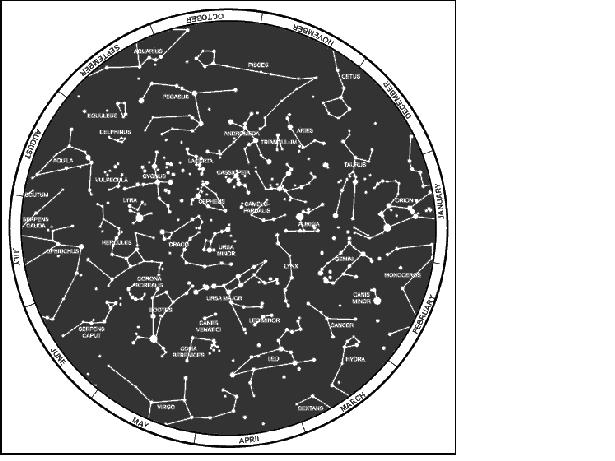FINDING NORTH BY CONSTELLATIONS-
Star Method
(1) Less than 60 of approximately 5,000 stars visible to the eye are used by navigators. The stars seen as we look up at the sky at night are not evenly scattered across the whole sky. Instead they are in groups called constellations.
(2) The constellations that we see depends partly on where we are located on the earth, the time of the year, and the time of the night. The night changes with the seasons because of the journey of the earth around the sun, and it also changes from hour to hour because the turning of the earth makes some constellations seem to travel in a circle. But there is one star that is in almost exactly the same place in the sky all night long every night. It is the North Star, also known as the Polar Star or Polaris.
(3) The North Star is less than 1° off true north and does not move from its place because the axis of the earth is pointed toward it. The North Star is in the group of stars called the Little Dipper. It is the last star in the handle of the dipper. There are two stars in the Big Dipper, which are a big help when trying to find the North Star. They are called the Pointers, and an imaginary line drawn through them five times their distance points to the North Star. There are many stars brighter than the North Star, but none is more important because of its location. However, the North Star can only be seen in the northern hemisphere so it cannot serve as a guide south of the equator. The farther one goes north, the higher the North Star is in the sky, and above latitude 70°, it is too high in the sky to be useful.
Figure . Determining direction by the North Star and Southern Cross.

(4) Depending on the star selected for navigation, azimuth checks are necessary. A star near the north horizon serves for about half an hour. When moving south, azimuth checks should be made every 15 minutes. When traveling east or west, the difficulty of staying on azimuth is caused more by the likelihood of the star climbing too high in the sky or losing itself behind the western horizon than it is by the star changing direction angle. When this happens, it is necessary to change to another guide star. The Southern Cross is the main constellation used as a guide south of the equator, and the above general directions for using north and south stars are reversed. When navigating using the stars as guides, the user must know the different constellation shapes and their locations throughout the world .
Figure . Determining Constellations, northern hemisphere.

Figure .determining Constellations, southern hemisphere.
|




No comments:
Post a Comment
முக்கிய அறிவிப்பு
விவாதப் பகுதியில் நீங்கள் பதிவு செய்யும் கருத்துகள் திட்டுவது, கொச்சைப்படுத்துவது, அசிங்கமான, திசை திருப்பும், பெருமை குலைக்கும், சட்டச் சிக்கலான, சட்டத்திற்குப் புறம்பான, எதிர்மறையான விளைவுகளை ஏற்படுத்தக்கூடிய, சர்ச்சையான, தரக்குறைவான வகையில் இருந்தால் அது தகவல் தொழில்நுட்பச் சட்டப் பிரிவு 79 உட்பிரிவு (2) மற்றும் 87 உட்பிரிவு 2(ஜி) கீ்ழ் சட்டப்படியான நடவடிக்கைக்கு உள்ளாக்கப்படும் என்பதைத் தெரிவித்துக்கொள்கிறோம்.